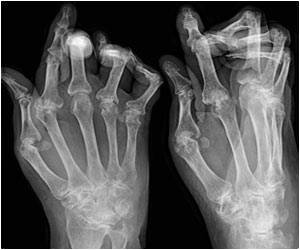Mayo Clinic has found that the painful rheumatic condition gout is often associated with the big toe.

In the gout study, researchers followed 46 gout patients for a mean of roughly 13 years. Most of the patients were male, and the mean age at which gout appeared was 66. They found that even though people usually associate gout with the big toe, the patients at highest risk for subsequent bouts with gout pain had gout originate in another joint, says co-author Eric Matteson, M.D., rheumatology chair at Mayo Clinic in Rochester, Minn.
"Because patients often think that a gout flare-up means their medications are not working, they may stop medications like allopurinol. It is especially important for these patients to continue taking gout medication to prevent flare-ups," Dr. Matteson says.
In other studies:
*Researchers found that African-American lupus patients with certain autoantibodies (anti-RNA-binding protein autoantibodies) have higher levels of interferon, a protein involved in inflammation.
"We know that African-American patients have worse lupus than patients who are Caucasian. We haven't really understood exactly why that is," says Dr. Matteson, who wasn't a co-author. "This increased expression of interferon may be one of the keys why African-American patients have worse lupus."
Advertisement
*Long-term blood pressure variability in rheumatoid arthritis patients and its impact on heart health was studied using patient data in the National Institutes of Health-funded Rochester Epidemiology Project. The finding: Rheumatoid arthritis patients had higher variability in their systolic blood pressure (the top number of a blood pressure measurement) from one health care visit to another than those without the disease, and that erratic blood pressure was linked to heart disease.
Advertisement
*In the osteoarthritis study, researchers used X-ray images known as CT scans to examine the joints of patients with advanced osteoarthritis. They spotted uric crystal deposits around joints similar to those that plague gout patients; however, the osteoarthritis patients didn't show symptoms of gout. Mayo plans more research to determine whether the crystals contribute to the severity of osteoarthritis or are simply a byproduct of it, says Dr. Matteson, who didn't take part in the study.
*Researchers examined how cigarette smoking promotes development of rheumatoid arthritis. Smoking doubles the risk of developing the disease. The study suggests that in those with a genetic predisposition to a particular immune response, smoking triggers immune system cells known as dendritic cells and leads to rheumatoid arthritis, an autoimmune disorder, says Dr. Matteson, who wasn't a co-author.
Source-Newswise










